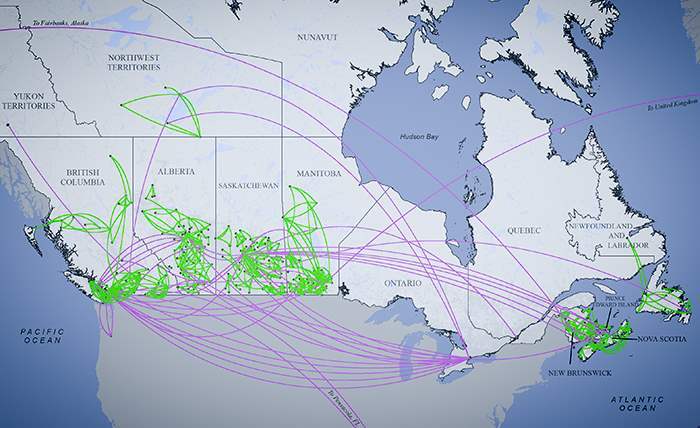Advice Seeking Networks in Long Term Care
What is the Advice Seeking Networks in Long Term Care Study?
The Advice Seeking Networks in Long Term Care project aims to identify the informal advice networks among leaders in Canadian long term care, and to use these networks to more effectively disseminate innovations throughout the sector.
A survey was distributed to senior leaders in 958 long term care (LTC) facilities across Western, Atlantic, and Northern Canada. It asked each senior leader to identify other individuals and institutions they seek advice from about care practices.
Survey respondents provided the names of both individuals and LTC facilities that acted as sources of advice and models for improving resident care. Led by TREC researcher Dr Jim Dearing of Michigan State University, we constructed maps of personal networks composed of individuals who are seekers and/or sources of advice, and organizational networks composed of LTC facilities that serve as models of care in the sector.
Why is it Important?
Promoting the use of best practices and new innovations can be difficult and time consuming. Their spread across the nursing home sector can, however, be important to quality care efforts. Engaging well connected people or well connected organizations is an important first step in adopting innovation. Once an innovation reaches a critical point (about 25%), it has gathered enough momentum to help ensure the innovation will ‘take off’.
By asking leaders in long term care who they seek advice from we can identify individuals and sites that are central in a sector’s networks making it possible to target them for early adoption and to spread innovations more rapidly.
This sector has never been mapped before; doing so helps both decision makers and researchers understand how strongly or weakly connected nursing homes are and where they are connected, how this occurs (e.g., within organizations, across other dimensions).
- This information assists with strategies for the spread of innovations.
- Where gaps are identified, efforts can be undertaken to build and strengthen networks.
- It identifies opinion leaders who may be able to lead in the implementation of current and future innovations.
- A targeted approach to implementation of new improvement initiatives and to roll out of operational programs can save time, money and resources.
Key Findings
The first research paper on the results of the Advice Seeking Networks Study was published in Implementation Science in February 2017. The paper provides an overview of the quantitative results of the survey distributed to senior leaders in 958 long term care (LTC) facilities across Western, Atlantic, and Northern Canada.
There is one large network for all of Canada. A single, informal advice-seeking network—rather than multiple fragmented networks—appears to span the country on the topic of LTC quality improvement. (See the map below illustrating the advice network between organizations)
Facility leaders often seek advice from those closest to them. Geographic proximity plays a big role in determining who seeks advice from whom. For example, less than 4 percent of all advice relationships at the personal and organizational levels crossed provincial or territorial boundaries. Most survey respondents showed a clear preference for seeking advice from colleagues and facilities within their province, and often, within their health authority, region, or zone.
43% of sources of advice work outside the nursing home setting. A substantial proportion of the individuals nominated as sources of advice in the personal network (43%) were those who do not work within a LTC facility but rather work for a provincial health authority or ministry, or at the corporate level of a chain of LTC facilities.

Presentations to community stakeholders
In addition to the knowledge translation webinars and summits held in 2015 and 2016, the Advice Seeking Networks team continues to present study results to various groups of community stakeholders. On December 8, 2016, we shared insights from the study as part of the brainXchange national webinar series, in partnership with the Alzheimer Society of Canada and the Canadian Consortium of Neurodegeneration in Aging (CCNA).
Other recent and upcoming presentations include those for the British Columbia Patient Safety and Quality Council in Vancouver, BC, Alberta Health Services Seniors Health Strategic Clinical Network in Edmonton, AB, and the Drug Evaluation Alliance of Nova Scotia (DEANS), part of the Nova Scotia Department of Health and Wellness, in Halifax, NS.
Publications
Cranley LA, Keefe JM, Taylor D, Thompson G, Beacom AM, Squires JE, Estabrooks CA, Dearing JW, Norton PG, Berta WB. (2017). Understanding professional advice networks in long-term care: An outside-inside view of best practice pathways for diffusion. Implementation Science, 14:10.
Dearing JW, Beacom AM, Chamberlain SA, Meng J, Berta WB, Keefe JM, Squires JE, Doupe MB, Taylor D, Reid RC, Cook H, Cummings GG, Baumbusch JL, Knopp-Sihota J, Norton PG, Estabrooks CA. (2017). Pathways for best practice diffusion: The structure of informal relationships in Canada’s long-term care sector. Implementation Science, 12:11.
Page Options


